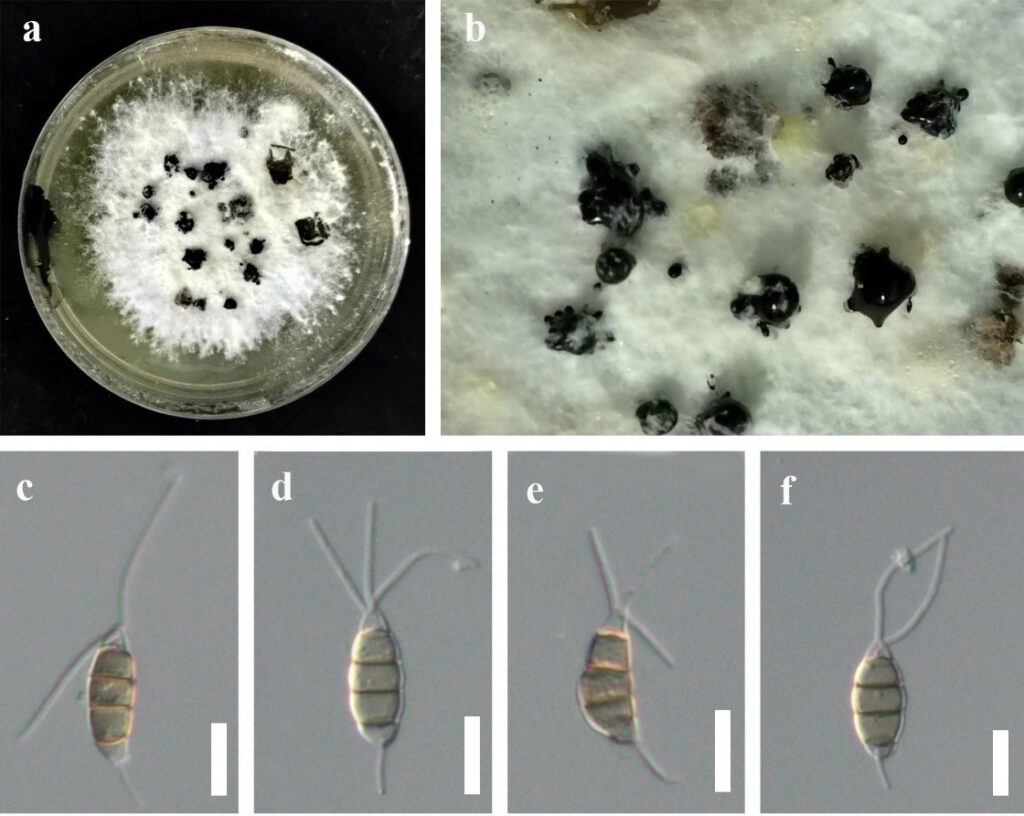Neopestalotiopsis hyperici Y.R. Sun & Yong Wang bis, in Sun, Jayawardena, Sun & Wang, Microbiology Spectrum: e03987-22, 5 (2023)
Index Fungorum number:IF 571228; MycoBank number: MB 571228; Facesoffungi number: FoF 12913;
Etymology – The specific epithet is referring to Hypericum, the host plant from which the fungus was isolated.
Holotype – HKAS 124561
Associated with leaf spots of Hypericum monogynum. Symptoms irregular shape, pale to brown, slightly sunken spots appear on the leaves of Hypericum sp., which later expand outwards. Sexual morph: Not observed. Asexual morph: Conidiomata solitary, unilocular, dark. Conidiophores often reduced to conidiogenous cells. Conidiogenous cells indistinct. Conidia17 to 22 (to 24) × 5 to 8 μm (x̄ = 19 × 7 μm, n = 30), L/W ratio of 2.8, fusoid, subcylindrical, straight to slightly curved, 4 septate; basal cell conic to obconic with a truncate base, hyaline to subhyaline, 2 to 4 μm long; three median cells 10 to 14 (to 17) μm long (x̄ = 12 μm, n = 30), wall rugose, concolorous; second cell from base pale brown to brown, 3 to 5 μm long; third cell pale brown to brown, 3 to 6 μm long; fourth cell pale brown to brown, 2 to 6 μm long; apical cell 1 to 4 μm long, hyaline, rugose and thin walled; with 2 to 3 tubular apical appendages, arising from the apical crest, unbranched, filiform, 11 to 23 μm long; single basal appendage 4 to 7 μm long, unbranched, tubular, centric.
Culture characteristics – Colonies on PDA reaching up to 10 cm after 2 weeks, dense mycelium on the surface, white from above and below. Fruiting bodies were observed after 14 days.
Material examined – China, Guizhou Province, Guiyang City, Baiyun District, Changpoling National Forest Park, leaf spot of Hypericum monogynum (Clusiaceae), 20 August 2021, Y.R. Sun, CL5-1 (HKAS 124561, holotype); ex-type culture, KUNCC 22-12597 = GUCC 21-0812; ibid., on leaf spots of Hypericum monogynum, 20 August 2021, Y.R. Sun, CL5-1-1, living culture KUNCC 22-12598 = GUCC 21-0811.
Notes – Neopestalotiopsis hyperici is related to N. rhododendri and N. protearum in the phylogenetic analyses (Fig 1), but they can be distinct from concolorous conidia and the size of their median cells (10.5–14.5 μm in N. hyperici vs. 13.5–19.5 μm in N. rhododendri vs. 16–17 μm in N. protearum (Maharachchikumbura et al. 2014, Yang et al. 2021). In addition, there are 13 base pairs differences between N. hyperici and N. rhododendri in the TEF region. Moreover, the PHI test on N. hyperici indicated that there is no significant recombination (Фw = 1.0) between N. hyperici and its closely related taxa (Fig 2b). Thus, we introduce N. hyperici as a new species.

Figure 5 – Neopestalotiopsis hyperici (MFLU 22-xx, holotype). a Culture. b Close up view of conidiomata. c–f Conidia. Scale bars: c–f = 10 µm.
